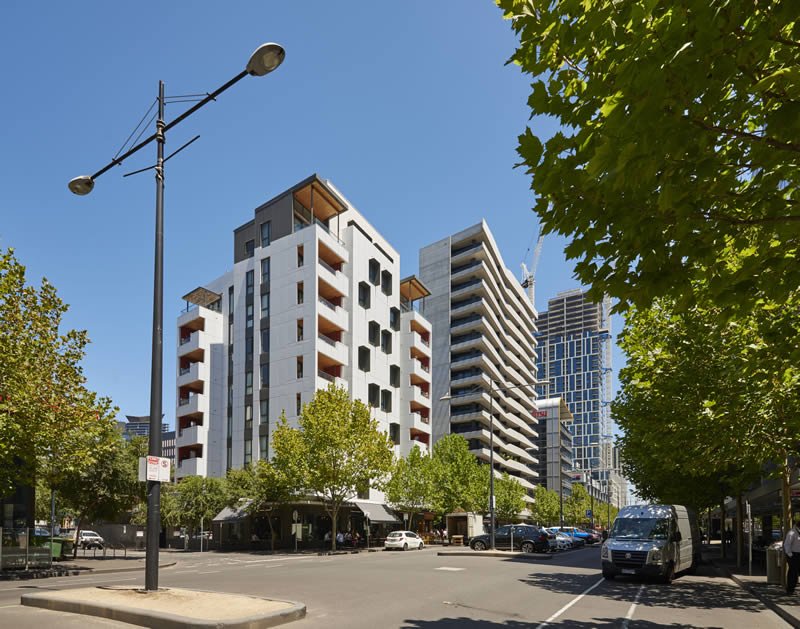Engineered timber is building a new future for the timber industry.
Forte Living in Melbourne is a 10 storey timber construction that was briefly the tallest timber building in the world. Treet, in Norway, reaches 14 storeys. Brock Commons at the University of British Columbia in Canada is 18 storeys tall. All of these timber constructions were made possible through the use of engineered timber products.
“The benefits of timber are well known to the construction industry but the size and availability of traditional timber products meant that they couldn’t be used in mass construction,” says Daniel Wright, National Marketing Manager at Australian Sustainable Hardwoods. “Engineered timber products make that possible from a renewable resource which offers ease of use, speedy and safe installation, carbon sequestration, low embodied energy, time savings and the ability to be constructed by your local chippy – with a little extra training.”
Developments in engineered timber such as CLT (cross laminated timber) and glulam are opening new doors for medium-rise timber construction, and the building industry is starting to pay attention.
“CLT has grabbed people’s attention,” says Dave Gover, CEO of the Engineered Wood Products Association of Australasia (EWPAA). “It’s made it easier for people to make the leap to timber medium-rise construction.
“CLT has made it simple as a solution for timber construction. Where the future opportunities lie is being able to take some of the other engineered products and make them part of the solution for timber medium-rise.”
While the use of timber is becoming much more common in residential construction, there are still many challenges ahead for the timber industry.
“In residential construction [engineered timber has] got pretty good penetration and is widely accepted,” Gover says. “It’s been in that market since LVL was first made in Australia in the late 1980s. The challenges are really around the medium rise – a different building industry with much bigger construction companies.”
However, some large construction companies, such as Lend Lease and Strongbuild are early adopters. With such big and influential names promoting the use of engineered timber products, other companies are sure to follow.
While the environmental benefits of using timber in construction are widely known, what many don’t realise is that from a construction point of view it can be more economically viable to use engineered wood.
“From the numbers that I’ve seen it certainly indicates that to be the case,” Gover says. “I’m not a quantity surveyor, but it certainly seems there are some good savings to be made.”
This is partly due to reduces foundation costs. With a lightweight structure you don’t need the same sort of depth of foundation to support it. There are also savings to be had from utilising prefabricated solutions, which reduce construction times and therefore costs.
Construction time and cost-saving is a big selling point. To capitalise on these benefits, Tilling Timber has developed SmartStruct – a comprehensive range of engineered wood systems that are quicker to construct, safer and more cost effective. Using Tilling products, an Australand project saw an installation rate of 400 square metres per working day, with four levels built within six weeks.
Other benefits of building with timber can be seen in countries such as New Zealand, which is prone to earthquakes. A more lightweight building is safer in an earthquake than a heavier structure, as a lightweight building is more likely to move with the land.
“Constant, predictable and stable – these are the three mainstays of all engineered timber over sawn timber that are valued by engineers and builders alike,” says George Dolezal, principal engineer at Meyer Timber. Meyer Timber have access to the full range of engineered timber. This includes beam elements such as LVL, I-joist, Glulam and LSL (laminated strand lumber), as well as panel elements incorporating OSB (oriented strand board) and CLT.
“Architects have always been drawn to the aesthetics of wood,” Dolezal says. “Now with engineered timber they have the opportunity to express this as part of the structure for large scale buildings. The flow-on effects which are generic to all timber are also appealing to the industry.”
Wright agrees: “There are many benefits of engineered timber which are usually to do with increased length, width, thickness and stability. In the case of Australian Sustainable Hardwood, the timber is still visually appealing because we use solid pieces of timber rather than veneers. This combination of benefits creates practical solutions for building specialists and allows timber to be used in applications where concrete and steel had dominated sales over the past century.”
AH offer a wide range of engineered timber products for both aesthetic and structural applications. The company aims to showcase real timber where needed, rather than gluing small veneers and negating the appearance of beautiful wood.
“This allows us to offer many of the benefits of engineering timber (such as increased width, thickness and lengths) with the benefits of solid timbers (nail retention, beauty, less energy consumption). These are mostly completed by using a combination of either finger jointing, laminating or both together. Our new Australian oak engineered flooring range, however, is made using a balanced construction of a plantation hardwood ply pressed to our locally grown, Eucalypt species.”
With so many beautiful, strong, energy- and cost-efficient products already on the market, it will be very interesting to see what the future holds for engineered timber.
“In the future for engineered wood products, the challenges that are obvious are in medium-rise construction,” Gover says. “But there are other challenges in other construction environments, such as bridges.
“There are also opportunities around wood utilisation – the manufacturing and supply end. Looking at lower value wood and how you can make that into a higher value product.”
Giver believes that we will begin to see more taller timber constructions as builders become more used to working with engineered timber products.
“It’s a combination of people developing a level of experience with the products that are available,” he says. “As they develop that experience, they will gain confidence and start to push the envelope, that’s where you’ll see change.
“People are talking about building 50 storey buildings. Technically is it feasible? Probably, it’s just a case of working out the economics of it.”
Dolezal belives that pre-fabrication using timber for larger structures is probably the next growth area.
“CLT utilises this to an extent,” he says, “but there are companies which are extending on this by supplying prefabricated panels with windows, doors, external facades and internal finished pre-installed. This adds to speed of construction while reducing the need for costly site expenses such as scaffolding.”
“There is still a lot to be done to raise awareness surrounding the use of timber in construction,” Gover says. “There’s uptake and the uptake has been significant. Ten years ago what was around for medium-rise timber – maybe two or three storeys? And that was a rarity. But now look what we’ve got! So yes, there is a lot more opportunity that hasn’t been realised yet.”
As the market gets more familiar with the current range of materials there will inevitably be more developments in current and new products to push the use of timber, however, it is important to realise that all products have their place.
“The most efficient building is not necessarily a complete timber structure,” Dolezal points out. “We need to be able to put the right product into the right application. By doing this you could create a hybrid building which has timber, steel and concrete components used to their best advantage. With this philosophy you might say the sky is the limit.”










